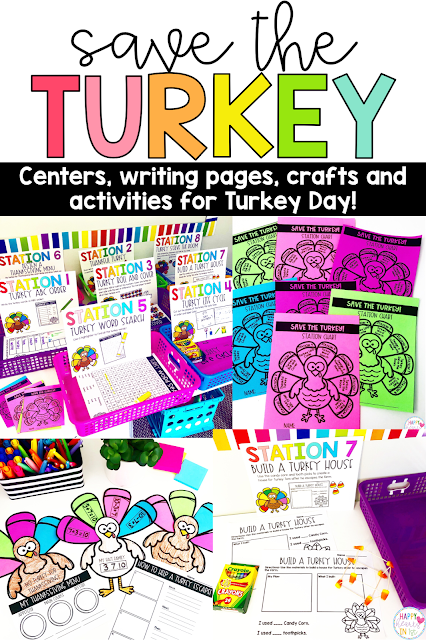Turkey Day!
The days leading up to Thanksgiving break always seemed to be the most exhausting for me as a teacher! Every year I was just so mentally and emotionally drained and ready for a break! I started doing Turkey Day (really Turkey week!) to get out of the funk and have some fun! The week before Thanksgiving turned into one of my absolute favorites in our first grade year! Keep reading to learn how we celebrate Turkey Day and find a FREEBIE at the end of the post!
All week long to get ready for Turkey Day, we read Turkey books! Each day we read a fiction or non-fiction Turkey book and complete an activity.
Finally the day before break is Turkey Day! In the morning, I tell my students we received a special note from a Turkey friend. I put this slide on my smart board and ask the students if we can work together today to complete all of the station challenges and help Turkey Tom!
We spend most of our day completing all of the Turkey Station Activities. I put students in teams of 2 or 3 and give each student a Turkey Station card so that they can track which activities they have visited. As they complete a station activity, they can add a sticker to their chart! The kids absolutely LOVE these charts. They get so excited to add the stickers and I love that they can take them home and share with their families about all the activities we did. I let the students complete the activities in any order they choose. The sticker chart helps them to keep track of which activities they still need to complete.
I set up our stations all around the classroom! Each station includes a Visual Station Directions sign. I included an option with the station number and without the station number. There are also mini station signs if you want to save paper! In my Turkey Day resource, I included an editable version of the station visual direction signs and the sticker chart so that you can use the activities that work best in your classroom.
Here are the stations I have my students complete. I included math and literacy activities along with some just for fun!
Station 1: Turkey ABC Order
Students will put a list of turkey words in ABC order.
Station 2: Thankful Turkey
Students will write and draw what they are thankful for in the turkey feathers. Then they can color their turkey.
Station 3: Turkey Roll and Cover
Students will roll 2 dice. They can choose to add or subtract the numbers on the dice. Then they can use a game marker to cover a turkey. The first partner to get their side of the game board covered is the winner! If playing in groups of 3, just use an extra game board and cover one side. I love using candy corn or turkey mini erasers as game markers.
Station 4: Turkey Life Cycle
Students will cut out pictures of the turkey life cycle and glue them in order. They can use the word bank to label each stage of the life cycle. We always read about the Turkey Life Cycle earlier in the week and go over it together using my turkey life cycle poster (included in the resource) so that students are familiar!
Station 5: Turkey Word Search
My students LOVE word searches. They work together with their team to find all of the turkey words. In my classroom I have timers at this station that they can set for 15 minutes. They try to find as many as they can in that time. When time is up they can choose to keep looking OR move on to the next station. I leave the word search key so they can get some help finding the rest of the words if time is up- this is totally optional though!
Station 6: Design a Thanksgiving Menu
No turkey for Thanksgiving!! Students get to choose an appetizer, main course, and dessert that they would serve for Thanksgiving! You can also choose to save this activity and pair it with a Turkey craft included in this resource.
Station 7: Build a Turkey House
This is definitely a favorite station. This is a low prep stem activity in which students use toothpicks and candy corn to build a house for Turkey Tom. I included two recording sheet options for this station. You could also choose to just let students build.
Station 8: Turkey Solve the Room – Add and Subtract
Students know the routine for Solve the Room because it is one of our weekly math centers. Students get their clipboards and a recording sheet and walk around the room looking for the task cards. They solve the problem on their card and write the answer on their recording sheet. After they complete all the cards, they can visit the Grading Station and check their own answers using the answer key and a special flair pen!
If you’re interested in a whole year of Solve the Room- you can find the bundle here!
We finish the day by completing a Turkey craft. I included 3 craft options.
Fact Family Turkeys
No Turkey for Thanksgiving!
This turkey craft can be paired with the Thanksgiving Menu activities that students completed during stations!
Turkey
I also included an option that could accompany any of the writing pages included in this resource!
Finally at the end of the day, I display this slide and tell students that they completed that challenge! As a reward I give them each a bag of “Turkey Toes” (candy corn) to enjoy before they go home! There is also a slide option that does not include the turkey treat!
I hope you all have wonderful Turkey Days! You can find all of the Turkey activities here!
Click HERE for a Turkey Freebie!


































